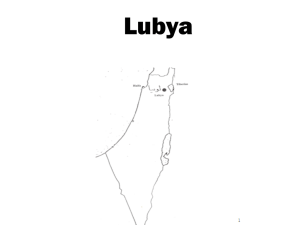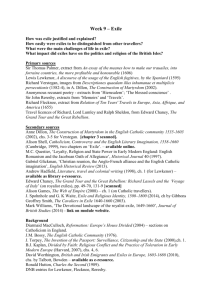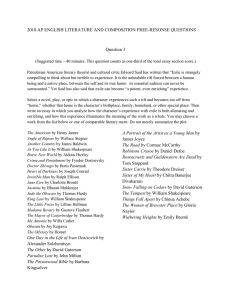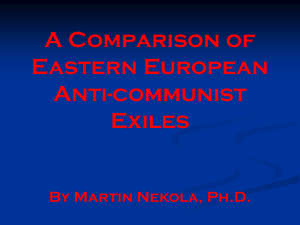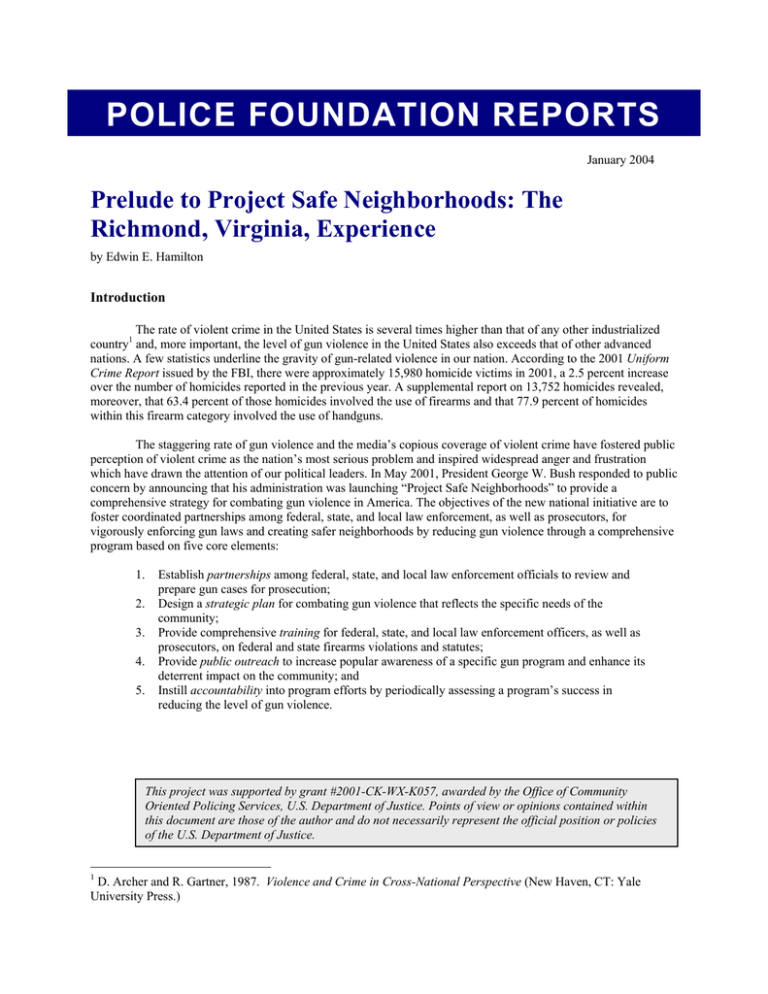
POLICE FOUNDATION REPORTS
January 2004
Prelude to Project Safe Neighborhoods: The
Richmond, Virginia, Experience
by Edwin E. Hamilton
Introduction
The rate of violent crime in the United States is several times higher than that of any other industrialized
country1 and, more important, the level of gun violence in the United States also exceeds that of other advanced
nations. A few statistics underline the gravity of gun-related violence in our nation. According to the 2001 Uniform
Crime Report issued by the FBI, there were approximately 15,980 homicide victims in 2001, a 2.5 percent increase
over the number of homicides reported in the previous year. A supplemental report on 13,752 homicides revealed,
moreover, that 63.4 percent of those homicides involved the use of firearms and that 77.9 percent of homicides
within this firearm category involved the use of handguns.
The staggering rate of gun violence and the media’s copious coverage of violent crime have fostered public
perception of violent crime as the nation’s most serious problem and inspired widespread anger and frustration
which have drawn the attention of our political leaders. In May 2001, President George W. Bush responded to public
concern by announcing that his administration was launching “Project Safe Neighborhoods” to provide a
comprehensive strategy for combating gun violence in America. The objectives of the new national initiative are to
foster coordinated partnerships among federal, state, and local law enforcement, as well as prosecutors, for
vigorously enforcing gun laws and creating safer neighborhoods by reducing gun violence through a comprehensive
program based on five core elements:
1.
2.
3.
4.
5.
Establish partnerships among federal, state, and local law enforcement officials to review and
prepare gun cases for prosecution;
Design a strategic plan for combating gun violence that reflects the specific needs of the
community;
Provide comprehensive training for federal, state, and local law enforcement officers, as well as
prosecutors, on federal and state firearms violations and statutes;
Provide public outreach to increase popular awareness of a specific gun program and enhance its
deterrent impact on the community; and
Instill accountability into program efforts by periodically assessing a program’s success in
reducing the level of gun violence.
This project was supported by grant #2001-CK-WX-K057, awarded by the Office of Community
Oriented Policing Services, U.S. Department of Justice. Points of view or opinions contained within
this document are those of the author and do not necessarily represent the official position or policies
of the U.S. Department of Justice.
1
D. Archer and R. Gartner, 1987. Violence and Crime in Cross-National Perspective (New Haven, CT: Yale
University Press.)
Prelude to Project Safe Neighborhoods:
The Richmond, Virginia, Experience
Page 2
Police Foundation Reports
January 2004
One of the building blocks of the Project Safe Neighborhoods initiative was Project Exile’s
success in reducing gun violence within Richmond, Virginia. Project Exile’s achievement has been largely
attributed to productive partnerships among the participating agencies and coordinated use of innovative
and aggressive policing strategies to reduce gun violence, two factors that were certainly important but did
not fully explain the program’s impact. Equally important was Project Exile’s focus on obtaining popular
support for an aggressive law enforcement approach to gun violence by constantly engaging the community
in its efforts. Had Project Exile not made a deliberate effort to enlist community support, the communities
that most suffer from gun violence could have undermined the program’s efforts. These communities are
often racially segregated and socially disenfranchised, and it is therefore crucial for policing strategies like
Project Exile to focus on promoting the legitimacy of law enforcement and building a community coalition
directed at the gun problem.
Facilitating the spread of Exile-type initiatives was a critical component of the nationwide
commitment to reducing gun crime through Project Safe Neighborhoods. With this in mind, the Police
Foundation, with support from the Office of Community Oriented Policing Services, held four symposiums
across the country: Omaha, Nebraska; Phoenix, Arizona; Newark, New Jersey; and Detroit, Michigan. The
symposiums were facilitated by the major players involved in the development of Project Exile: Jerry
Oliver, former chief of police in Detroit, MI, and Richmond, VA; James Comey, Deputy Attorney General
of the United States, former U.S. Attorney, Southern District of New York, and former Deputy Assistant
U.S. Attorney, Richmond, VA; and David Hicks, Commonwealth Attorney, Richmond, VA.
The symposiums had several fundamental objectives. The first was to inform practitioners— such
as police chiefs, sheriffs, district attorneys, correctional officials and administrators—about a model,
interagency initiative to combat guns and violence. More important, however, was to provide insights on
the strength of the partnerships that were established and the importance of building and maintaining
community trust and support, factors that were ultimately critical to the success of Project Exile.
Project Exile Background
The concept of Project Exile arose out of a partnership formed in 1996 by the Richmond, VA,
Police Department; the United States Attorney for the Eastern District of Virginia; and the
Commonwealth’s Attorney’s Office for the City of Richmond. The three organizations envisioned Project
Exile as an innovative and alternative strategy to address guns and violent crime, problems that centered in
Richmond on the unusually high number of homicides associated with drug trafficking. This association
between drugs and violent crime was not, of course, unique to Richmond, but unlike other large U.S. cities
in the 1990s, Richmond had seen its crime rates climb rather than decline. The results, as former U.S.
Attorney James Comey remarked to the Newark Symposium, was for U.S. Attorney General Janet Reno to
euphemistically designate Richmond as one of America’s “special cities” and for Richmond citizens to
“Thank God for Gary, Indiana,” the only U.S. city that had an even more abysmal crime rate.
Violent crime was ubiquitous in Richmond because it was commonplace for people to carry
firearms in public places. The average criminal, as Comey quipped to the Phoenix audience, put on pants,
shirt, socks, and gun with equal reflection. In a city where everyone on the street saw a gun as a “necessary
article of clothing,” firearms were used to settle everything from a minor spat over a girl to a major dispute
over a drug deal. Though few people in Richmond deliberately set out to commit murder, Comey added,
the widespread practice of carrying firearms led to many spontaneous gunfights and happenstance
homicides, particularly among young African-American men.
When Richmond’s homicide rate exploded in 1996, local and federal prosecutors, police officers,
and the FBI formed a task force to implement Project Exile. In doing so, they relied on a long list of drug
crimes that had largely been lying dormant on the books since Congress began passing them in 1987.
According to the fundamental concept of the program, criminals who were found carrying guns by the
police were exiled to out-of-state facilities rather than being permitted to serve out their sentences in a local
Prelude to Project Safe Neighborhoods:
The Richmond, Virginia, Experience
Page 3
Police Foundation Reports
January 2004
jail, in comfortable proximity to family and friends. Project Exile also provided for immediate, federal
prosecution on the basis of federal statutes that imposed stiffer sentencing guidelines than state laws,
imposed mandatory minimums for possession of firearms, and eliminated much of judges’ sentencing
discretion, as Comey related to attendees in Newark. These federal prosecutions, to be specific, were
carried out under the following United States Codes:
•
18 USC § 922 that prohibits possession of firearms while possessing drugs; by convicted felons; if
a person is a fugitive from another state; if an individual is under a felony indictment; if the person
is the subject of a restraining order; by a drug user; if an individual has been involved in prior
domestic violence; or if the gun is known (by the possessor) to be stolen.
•
18 USC § 924 (c) that carries a mandatory five-year incarceration term for carrying a firearm in
connection with drug dealing or any prohibitions listed above; possession of a firearm in
furtherance of a drug-trafficking crime or crime of violence.
Any criminal who was found in violation of federal laws relevant for Project Exile faced immediate federal
prosecution. Criminals meeting one or more of those legal criteria were sentenced to an average prison term
of sixty-one months. In thus raising the stakes, as Comey summed up, Project Exile imposed costs on crime
in gun-happy Richmond that made people think more about guns than about their shoes.
Project Exile was indeed an effective deterrent as shown by a few statistics. In 1997, prior to the
implementation of Project Exile, approximately 85 percent of Richmond’s homicides were committed with
guns, with more than 40 percent of them being drug related and more than 60 percent involving offenders
with prior criminal records. By 1998, when the program had been in operation for ten months, the number
of homicides decreased by 35 percent from the previous year and homicides committed with a firearm were
down by 41 percent. Since the inception of Project Exile, 890 persons have been indicted, 64 percent of
whom were detained without bond. As a result, 1,040 guns have been removed from Richmond’s streets
and kept out of the hands of criminals.2
PART I:
Building and Maintaining Community Trust and Support for Gun
Reduction Initiatives
The tremendous contribution that Project Exile made to Richmond’s fight against gun violence
significantly reflects three important components of the program:
1.
2.
3.
A high degree of interagency cooperation and commitment among the various partners of the
program;
Innovative public outreach/education to increase community awareness of the program; and
Commitment to building and maintaining community trust and support for an aggressive law
enforcement campaign against gun violence.
The following discussion of the obstacles, challenges, and successes that Richmond experienced
in implementing these components of Project Exile will hopefully serve as a guide for other law
enforcement agencies interested in launching a similar strategy.
Interagency Partnerships
The success of Richmond’s Project Exile has been largely attributed to the unique partnerships
established among the federal, state, and local law enforcement agencies that participated in the initiative.
The list of participants in the program included the Richmond Police Department; the U.S. Attorney’s
2
Richmond (VA) Police Department, “Summary Statistics—Project Exile Cases,”
http://www.ci.richmond.va.us/police/exile/pdxxr_exilestats.asp; accessed January 24, 2003.
Prelude to Project Safe Neighborhoods:
The Richmond, Virginia, Experience
Page 4
Police Foundation Reports
January 2004
Office for the Eastern District of Virginia; the Virginia Attorney General; the Richmond Commonwealth’s
Attorney’s Office; the Bureau of Alcohol, Tobacco, and Firearms; the Federal Bureau of Investigation; and
the Virginia State Police. Notwithstanding some of the differences in training, responsibilities, and agendas
that distinguished these agencies, they all recognized that a high degree of interagency cooperation and
commitment were essential to the viability of Project Exile. The high degree of interagency cooperation
and commitment demonstrated by these participating agencies was essential to the success of Project Exile.
As Commonwealth Attorney David Hicks emphasized to the Newark symposium, a strategy like Project
Exile will falter unless participants form partnerships in which they work together, understand what the
others are doing, and provide mutual support against detractors.
Unfortunately, it can be a difficult task to establish such strong and coordinated partnerships
among various agencies, particularly when one considers that most multi-agency efforts are impeded by the
conflicting agendas that frequently exist among partner agencies. Richmond’s Project Exile was able,
however, to overcome the barriers associated with forming partnerships and to establish a unique
relationship based on the mutual dedication, commitment, and cooperation of its participating agencies.
Richmond accomplished this feat by recognizing a number of factors that should also be acknowledged by
other cities that want to ensure a uniform and comprehensive approach to reducing gun violence. These
critical elements for forming and achieving a successful partnership include:
•
Agreement as to the expected roles—To be effective, each organizational entity must examine its
respective role in the partnership. Understanding the contributions of each organization in the
mutual endeavor fosters a sense of credibility for the partnership’s efforts and helps mitigate the
conflicts in agenda that can occur among participating agencies.
•
Trust in each other—Participating agencies in the partnership must learn to trust each other, be
confident in the others’ decision-making capabilities, and be willing to stand by those decisions.
It’s easy to claim part of the credit when an initiative is going smoothly, but an ideal partnership
requires willingness to accept blame together as part of a team effort. This recognition that the
sum is greater than the parts underlay the efforts that Commonwealth Attorney David Hicks made
to counter municipal legislature’s initial reluctance to support Project Exile, particularly where
funding was concerned. With the support of the U.S. Attorney, the legislature changed its mind,
however, and provided resources critical to the program’s success. By working together to resolve
a source of mutual concern, the participants in Project Exile came to know each other better, gain
knowledge of the problem from different perspectives, and establish an enduring relationship
premised on mutual trust.
•
Demonstrate support and commitment to the initiative—Each agency must provide full support
and commitment to the partnership to achieve success. The Richmond Police Department
demonstrated its commitment to reducing gun violence by allowing the U.S. Attorney’s Office to
conduct training programs for all officers on federal firearms statutes and due process
requirements for the investigation of gun cases prior to Project Exile’s implementation. The police
department also contributed invaluable resources by assigning three full-time officers to Project
Exile. In addition, David Hicks, as he pointed out in his Omaha presentation, gave his support to
Jerry Oliver when the chief was questioned about his department’s clearance rate for homicides.
•
Communication—Participating agencies in any partnership must communicate with each other on
a continual basis to establish a good working relationship. Effective communication among the
participating agencies encourages a sense of “ownership” in the initiative and enhances the
credibility of the partnership’s efforts.
Prelude to Project Safe Neighborhoods:
The Richmond, Virginia, Experience
Page 5
Police Foundation Reports
January 2004
Public Outreach/Education
The second key to the success of Richmond’s Project Exile was its innovative public outreach
program to educate the public about the enforcement strategy and to build a community coalition directed
at the problem of gun violence. Law enforcement, as James Comey phrased it, ventured out into the
marketplace “to sell deterrence and market fear to the criminal community.” Its success in doing so was
fostered by the financial support of Richmond’s media and business community, both of whom cared
deeply about the city’s gun problem. Drawing on the tools of advertising, Project Exile launched a number
of publicity campaigns to communicate its message to gun criminals or community residents who might
have information about gun-related crimes. These efforts to modify the culture and behavior of city
residents relied on the following marketing vehicles:
•
•
•
•
•
Creation of a powerful Project Exile slogan which warned that “An illegal gun gets you five
years in prison;”
Laminated business cards distributed by police officers bearing the Project Exile slogan;
Television and radio commercials;
Billboards throughout the city that bore the Project Exile slogan and were supported by local
business;
A city bus, or “Death Bus” as it was nicknamed by local residents, that was wrapped with
Project Exile’s slogan and sent on a different route every day to make people think the city
had a fleet of such buses.
Project Exile’s outreach and education efforts thoroughly saturated the community, and this, in
turn, resulted in increased citizen reports about guns, which consequently maximized the community’s
support of law enforcement’s efforts to reduce gun violence. Fundamental to this approach was the effect
the publicity campaign had on its target audience of gun-carrying criminals. By concentrating its marketing
efforts on curtailing the accepted gun-carrying culture of criminals, the campaign persuaded many
criminals to view carrying a gun as a liability that could lead to a long prison sentence if detected by the
police. As a result of the change in criminal culture brought on by Project Exile’s publicity campaign, gun
seizures by the police decreased, as did homicides committed with a firearm.
Involvement of the Community
Equally important to the success of Project Exile was its emphasis on citizen involvement in the
fight against gun violence. Project Exile’s ambitious publicity campaign certainly contributed significantly
to public knowledge of its enforcement strategy, increased collaboration between citizens and police, and
promoted the legitimacy of law enforcement’s efforts to end gun violence, particularly within a minority
community that had historically mistrusted the police. For Project Exile to be truly accepted, however, it
had to establish a new climate in which members of the community could actively partner with police to
deter criminals from carrying guns and foster socials norms that rejected gun violence. What was called for
in effect, as Police Chief Jerry Oliver explained to the Detroit symposium, was “industrial strength
community policing” or “community policing on steroids.”
The policing model envisioned by Oliver required the Richmond Police Department to make
community policing an integral and pervasive part of its agenda rather than a specialized unit or program
within the agency. This entailed an ongoing effort to involve the community in the decision-making
process and give Richmond’s citizens the opportunity not only to identify problems but also to help police
formulate strategies and tactics to resolve them. This approach had previously worked, as Oliver noted, to
mitigate community outrage when a Richmond SWAT team accidentally shot an innocent woman in the
course of a drug raid. What would have escalated into a major scandal under other circumstances dissipated
in one day because Richmond citizens had been involved in purchasing the equipment responsible for the
accident and had asked the department to rid the woman’s neighborhood of drug dealers. Oliver
encouraged similar community involvement in the development and implementation of Project Exile
Prelude to Project Safe Neighborhoods:
The Richmond, Virginia, Experience
Page 6
Police Foundation Reports
January 2004
because he knew that an aggressive program like Exile can easily create problems for a police agency that
lacks a solid foundation of community trust and support.
Police chiefs, as Oliver has emphasized, need to know that their departments are continually
investing in a community trust account and building relationships that will withstand the kind of trauma
that Project Exile can provoke. The police chief needs to ensure members of the community that the
department is aware of their problems, cares about addressing them, and has what Oliver describes as “the
will to win.” The police department, in short, must clearly demonstrate to people that they are not alone in
their struggle to make their community a safe place to live.
Oliver acted on these ideals by soliciting community involvement in Project Exile almost as
though he were pursuing a political campaign, according to David Hicks’ account of the chief. Oliver
asserted his commitment to community involvement at a series of small gatherings with community
residents, meetings with civic leaders, and other public forums. In the course of these various meetings,
Oliver and Richmond police made significant efforts to gain community support for Project Exile by:
•
•
Defining the rationale justifying their aggressive strategy; and
Delineating the benefits the community would derive by endorsing an aggressive approach to
the problem of gun violence.
Project Exile’s exemplary success in building and maintaining community support required a
strong commitment to the philosophy of community policing. By involving the community in the
department’s practices and procedures, Richmond police gained the community’s trust in the department,
as well as its cooperation in Project Exile. The community, in effect, acquired a sense of ownership in
Project Exile, which ultimately caused it to embrace the program. All part of the game plan, for as Jerry
Oliver remarked in Newark, “You can’t have an aggressive initiative like Project Exile without having a
coexisting program of Project Embrace.”3
This sustained commitment on the part of the Richmond Police Department and the other
participating agencies has resulted in notable triumphs for Project Exile, as we have shown. There are,
however, significant challenges that must be overcome to strengthen the working relationships of the
partnership. Some of these challenges are outlined below.
PART II:
Overcoming Obstacles and Barriers to Successful Gun-Reduction Strategies
Resistance by Federal District Judges
One challenge was the initial resistance of federal district judges to increasing the workload of
federal courts by making them handle gun cases that could technically be addressed by state courts. To
overcome these reservations, the U.S. Attorney for the Eastern District of Virginia met with the judges to
discuss the potential value of Project Exile for community safety and to solicit their support of the
initiative. The Commonwealth Attorney’s Office, moreover, offered to assist by handling some of the gun
cases provided that defendants could face federal prosecution. In the end, the joint efforts of the U.S.
Attorney and the Commonwealth Attorney’s Office demonstrated the effectiveness of the Project Exile
partnership by making the judges more aware of Project Exile’s beneficial impact on gun violence and
deflecting their criticism of the initiative.
3
Under Project Embrace, former Exile offenders would have received resources to help them find a job, a
place to live, and perhaps even the tools needed to start their own business, “Street Talk,” Richmond.com,
http://www2.richmond.com/styleweekly/output.cfm?ID=1660732.
Prelude to Project Safe Neighborhoods:
The Richmond, Virginia, Experience
Page 7
Police Foundation Reports
January 2004
Loss of Continuity Resulting from Leadership Changes
Project Exile is now facing another challenge to the partnerships that were originally responsible
for its genesis. As time has progressed, some of the individuals who were instrumental in development
Project Exile have stopped working for the City of Richmond. The charismatic, managerial qualities of
these individuals and their personal commitment to the program were invaluable components of the
relationships established in the initial partnership. Their absence, as a result, has also weakened total
commitment and support for Project Exile within the existing partnership, presenting Richmond with the
challenge of somehow transferring the original enthusiasm and commitment of these individual players to
an institutional level within the various partner agencies. A successful response to this challenge is
important for ensuring the long-term success of Project Exile in continuing to reduce gun violence.
Lack of Resources
A significant challenge to Project Exile was the need to find available funding to support the
initial development of its public outreach and education component. The Project Exile partnership rose to
this challenge by holding meetings with local businesses, faith-based organizations, and civic leaders to
describe the program and its anticipated impact on gun-related violence and to solicit their financial
contributions. The Project Exile partnership also assisted them in fund-raising initiatives by establishing the
Project Exile Citizen Support Group, a nonprofit organization designated to receive tax-exempt donations
to Project Exile. These efforts proved to be vital to the success of the public outreach and education
component to increase community awareness and commitment to Project Exile.
PART III:
Recommendations for Implementing Successful Gun Reduction Programs
As noted earlier, one of the objectives of each of the four symposiums was to provide law
enforcement officials with insights on the critical elements that contributed to the success of Project Exile
in Richmond. The other objective of the symposiums, as of this report, was to provide guidance to federal,
state, and local law enforcement agencies, as well as prosecutors, on the critical factors needed to introduce
an Exile-type gun reduction program into their respective jurisdictions. Given that different communities
experience their own distinct patterns of gun violence, providing specific guidelines is less important than
giving law enforcement officials general guidelines for developing specific strategies to reduce gun
violence in their communities. The following recommendations were based on the responses of symposium
presenters to inquiries of attendees who were interested in implementing a similar strategy in their
communities.
Recommendation 1: To ensure that a uniform and comprehensive approach is taken for the specific gun
violence problem in a community, the police agency needs to develop close ties with local prosecutors and
the U.S. Attorney’s Office by directly involving them when initially formulating a specific program and by
maintaining a continuing liaison on efforts to reduce gun violence. In light of the Project Safe
Neighborhoods initiative, every U.S. Attorney is now required to coordinate all gun-related programs at the
federal, state, and local level within their respective district. This requirement works to the advantage of
police agencies by facilitating their collaboration with federal and local prosecutors in identifying the
specific type of gun cases that will have priority for review and prosecution.
Recommendation 2: Establish an inter-agency task force among federal law enforcement agencies, such
as the ATF, DEA and FBI, to assist in coordinated, gun-reduction programs. Inclusion of these agencies in
such programs has the significant advantage of providing much-needed expertise and useful investigative
resources.
Recommendation 3: The police agency should explore the possibility of state and federal grants as
potential funding sources to supplement the gun-reduction program. Grant funding may be applied toward
personnel expenditures, such as overtime costs, or technology, such as computers and computer mapping
Prelude to Project Safe Neighborhoods:
The Richmond, Virginia, Experience
Page 8
Police Foundation Reports
January 2004
software for tracking gun patterns, that will advance the goals of a given gun-reduction program. Other
potential funding sources may include use of asset forfeiture funds or creation of a nonprofit organization,
such as Richmond’s Project Exile Citizen Support Group, to raise private funds in support of the gunreduction program.
Recommendation 4: The established partnership agencies should work closely with business and
community leaders to develop an aggressive marketing strategy and publicity campaign for the gunreduction program. An effective marketing and publicity campaign will increase public awareness of a
specific program and help enhance its deterrent impact on the community. To assist in this type of
endeavor, the Project Safe Neighborhoods web site (www.projectsafeneighborhoods.gov) provides
download posters, handouts, and other materials that neighborhoods and community groups may use to
inform the public about efforts to reduce gun-related crime and violence.
Recommendation 5: Building and maintaining community support for a specific gun-reduction program is
essential to its success. A police agency that wants to implement an Exile-type program must assume a
leadership role in the process of building and maintaining community support and trust. A strong
commitment to the concept of community policing is the catalyst for law enforcement’s efforts to build
bridges between police and the communities they serve. Engaging the community’s involvement when
implementing the initial stages of a gun-reduction program will lend the initiative an aura of legitimacy and
give the community an opportunity to take an active role in ensuring its own safety and quality of life.
About the Police Foundation
The Police Foundation is a private, nonpartisan, nonprofit organization dedicated to supporting innovation
and improvement in policing. Established in 1970, the foundation has conducted seminal research in police
behavior, policy, and procedure and works to transfer to local agencies the best information about practices
for dealing effectively with a range of important police operational and administrative concerns.
Our purpose is to help the police be more effective in doing their job, whether it is deterring robberies,
intervening in potentially injurious domestic disputes, or working to improve relationships between the
police and the communities they serve. To accomplish our mission, we work closely with police officers
and police departments across the country, and it is in their hard work and contributions that our
accomplishments are rooted.
The foundation has done much of the research that led to a questioning of the traditional model of
professional law enforcement and toward a new view of policing—one emphasizing a community
orientation. For example, research on foot patrol and on fear of crime demonstrated the importance to crime
control efforts of frequent police-citizen contacts made in a positive, non-threatening way. As a partner in
the Community Policing Consortium, the foundation, along with four other leading national law
enforcement organizations, plays a principal role in the development of community policing research,
training, and technical assistance.
Sometimes foundation research findings have challenged police traditions and beliefs. When police
agencies employed routine preventive patrol as a principal anti-crime strategy, a foundation experiment in
Kansas City showed that routine patrol in marked patrol cars did not significantly affect crime rates. When
police officials expressed reservations about using women on patrol, foundation research in Washington,
DC, showed that gender was not a barrier to performing patrol work. To address the intense debate about
how police should respond to incidents of domestic violence, the foundation conducted the Minneapolis
Domestic Violence Experiment—the first scientifically controlled test of the effects of arrest for any crime.
Foundation research on the use of deadly force was cited at length in a landmark 1985 U.S. Supreme Court
decision, Tennessee v. Garner. The court ruled that the police may use deadly force only against persons
whose actions constitute a threat to life.
The foundation provides a wide range of services to law enforcement agencies and to state and local
governments. These services focus on establishing trust through improved accountability, leadership, and
professional development and on providing tools to help police more effectively manage resources. The
Crime Mapping & Problem Analysis Laboratory operates with the goals of providing practical assistance
and information to police departments and to developing the physical and theoretical infrastructure
necessary for further innovations in police and criminological theory.
Motivating all of the foundation's efforts is the goal of efficient, effective, humane policing that operates
within the framework of democratic principles and the highest ideals of the nation.
1201 Connecticut Avenue, NW
Washington, DC 20036-2636
(202) 833-1460
(202) 659-9149 fax
E-mail: pfinfo@policefoundation.org
www.policefoundation.org
© 2003 Police Foundation. All rights reserved.


